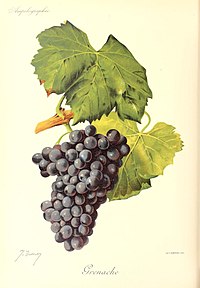
Photo from wikipedia
Aim: In this study, we aimed to evaluate the composition of grapes and wines of the Alicante Bouschet variety from a tropical semi-arid area in Brazil, by studying two rootstocks… Click to show full abstract
Aim: In this study, we aimed to evaluate the composition of grapes and wines of the Alicante Bouschet variety from a tropical semi-arid area in Brazil, by studying two rootstocks and harvests in different semesters (climates) of the same year.Methods, Results: Vines of Vitis vinifera L., Alicante Bouschet, a teinturier variety, were grown in a tropical semi-arid climate in Brazil. The phenolic composition of the grapes and wines was measured to assess how they had been affected by two rootstocks (IAC 572 and 1103P) and two harvest seasons, Semester 1 and Semester 2 (in this region, a grapevine produces two harvests per year, with an intra-annual climate variability). The grapes and wines were subjected to the usual physicochemical analyses, as well as to spectrophotometric and chromatographic analyses. Sensory analysis was carried out by professional tasters. The results show that there is a rootstock effect and a harvest season effect for several parameters on grape composition, as well as on the resulting wines. The grapes from vines grafted onto IAC 572 rootstock contained higher titratable acidity, tartaric acid, malic acid, total anthocyanins, total proanthocyanidins in skins and seeds and polymeric tannins in skins. The grapes from vines grafted onto 1103P rootstock contained higher concentrations of total phenols and non-flavonoids, total monomeric anthocyanins, monomeric and polymeric tannins in the seeds. The second semester wines were higher in total anthocyanins, total phenols, flavonoids and non-flavonoids, condensed tannins and low molecular weight flavanols, astringency potential, colour intensity, titratable acidity, total dry extract and alcohol content.Conclusions: The results demonstrate an influence of rootstock and harvest season (semester/climate) on grape and wine composition. Some of the grape and wine phenolic compounds analysed individually (some monomeric anthocyanins and low molecular weight flavanols) were higher in the first semester than in the second. The overall phenolic parameters determined in grapes and wines from the second semester were higher than those from the first. According to the sensory analyses, the semester (climate) effect was stronger than the rootstock effect, and the wines from the second semester received the highest scoring than those from the first semester, mainly for olfactory and gustatory attributes.Significance and impact of the study: This study uses a holistic methodology, mainly with respect to the phenolic compounds, to examine the combined effects of rootstocks and intra-annual climate variability on grape and wine composition. The results of this study may contribute to future research, as well as help the producers and wine companies of tropical regions to tailor viticultural and oenological parameters, in order to improve the quality and typicality of the products.
Journal Title: OENO One
Year Published: 2020
Link to full text (if available)
Share on Social Media: Sign Up to like & get
recommendations!